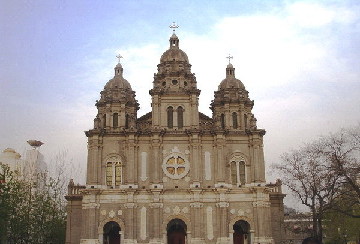 Northern Church
Northern Church
The Northern Church, formerly located at Canchikou (opposite to the old Beijing Library) near Zhongnanhai, was established and opened in 1703, and was torn down in 1887 due to the expansion of Zhongnanhai. In the Qing Dynasty (1644-1911), it was rebuilt in Xishiku inside Xi'anmen with 450,000 taels of silver from the government. One floor was added to the church in the renovation in1900. Hence it becomes the majestic and beautiful Northern Church that we see today.
Northern Church is a typical Gothic architecture. Four tall spires, three peaked arch entrances and rosaces make the fa?ade dignified and gorgeous. The church looks more pure white and upright with surrounding pines and cypresses. On both sides of the church front, there stand two Chinese pavilions with yellow glaze and four curving cornices on the roof. There is a stele inscribed personally by Emperor Qianlong inside each pavilion. These constructions, one high and one short, one in western style and one in Chinese style, are arranged skillfully. The saint statuaries on both sides of the main entrance are unique among the churches in Beijing. After the restoration in 1985, the church became more dazzling and the most ornate church in Beijing.
 Eastern Church
Eastern Church

The Eastern Church, located at famous Wangfujing Avenue in Beijing, was first established in 1655, and was the apartment Emperor Shunzhi of the Qing Dynasty (1644-1911) granted to two foreign priests. They built a small church on the open ground. Later the church was ruined in earthquakes and wars several times. It was rebuilt in 1904. After the restoration in 1980, it was reopened.
Because of the geographic position, the Eastern Church faces west. It follows Romanesque style. The strong pilasters and one high and two low vaults present it a massive architecture style. In order to smooth the expansion of Wangfujing Avenue, Beijing Municipal Government set aside RMB 130 million yuan for the restoration of the whole church.
 Western Church
Western Church
The Western Church, located on the southern side of Xizhimen Nei Street, is the youngest church among these four churches. The Western Church was first established in 1723 and restored in 1912. Because the pharmacy factory beside it has not been moved yet, it nearly cannot be seen from the street. But delicate Collins pillars and Gothic peaked arch inside the church make it grand, elegant and solemn.
 St. Michael's Church
St. Michael's Church
The St. Michael's Church in Dongjiaomin Alley was first built in 1901. Dongjiaomin Alley was a special zone for foreigners during the late years of the Qing Dynasty, and almost all embassies were built here. The St. Michael's Church was specially built for foreigners living here, and it belongs to Beijing parish now. Its entrance is in the south, and the whole building follows typical Gothic style. Three main peaked spires and several spire ornaments bring out the best in each other.
 The Dongguantou Church
The Dongguantou Church
The Dongguantou Church is the smallest of the eight Catholic churches in Beijing city. The Dongguantou Church is located at Dongguantou Village of Fengtai District in southeastern Beijing. The time when it was first built is not known. There used to be an ordinary one-storey house, which was torn down in 1991, and a new church was built at the same place. The style of the church reflects the architect's inspiration, the fa?ade is proportional, and the two warped cornices resemble flying wings and show its individuation.
 Longzhuang Church
Longzhuang Church
The Longzhuang Church is located in Tongzhou, suburb of Beijing. There used to be an old church. Local people said that it had been there for more than 100 years, but the exact time cannot be confirmed. In 1998, the Longzhuang Church was rebuilt in the west of the village. It is a red brick construction and faces south. The towering spire points to the blue sky, making the church spectacular.
 Housangyu Village Church
Housangyu Village Church
The Housangyu Village Church is located in Mentougou, suburb of Beijing. It was the oldest Catholic church in Beijing. According to historical records, it was originally a small church built in 1334, with stone-carved poodles in front of it and carved with eight Chinese characters Zhen Zai Ji Li, Huai Lin De Yi (bringing good luck to the house and lofty moral to the world).
The Housangyu Village Church was expanded in 1896, and was rebuilt in 1988. With the grand view of mountains, the towering white spire looks striking and splendid. In line with the mountain shape, a winding road was constructed towards the Virgin Mary Hill at the mountainside, which presents a unique view. The church once made contribution to the War of Resistance Against Japanese Invasion.
